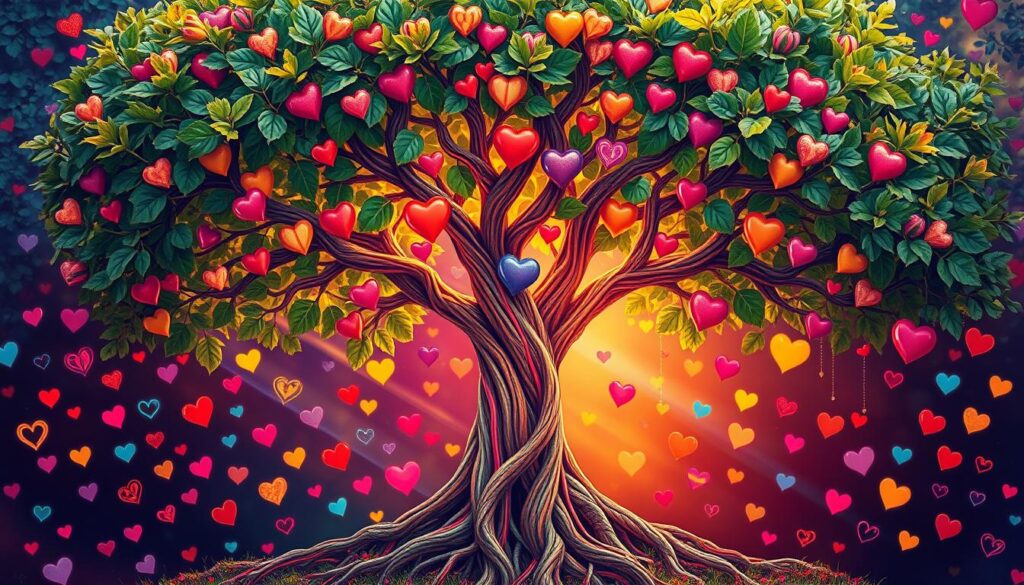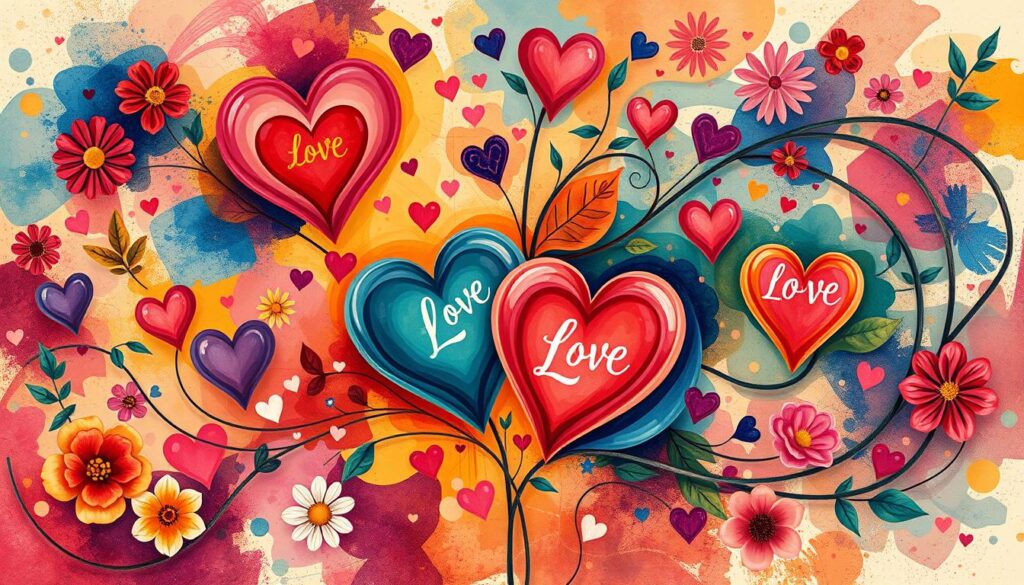Love is a big part of being human, like needing to eat and sleep. It has been explored in art and media for ages. Dr. Susan Albers says Robert Sternberg’s Triangular Theory of Love explains relationships well.
It says relationships need three things: an emotional bond, physical attraction, and a choice to stay together. This theory finds eight kinds of love, like non-love and romantic love. It even talks about the perfect love, called consummate love.
Key Takeaways
- Relationships are built on three core components: intimacy, passion, and commitment
- There are eight recognized types of love, each with varying levels of these key elements
- Consummate love, the ideal form, requires a perfect balance of all three components
- Love can develop rapidly, with feelings of attraction and infatuation occurring in a matter of seconds
- Understanding the different types of love can provide insight into the nature of your own relationships
The Science Behind Love and Relationships
The world of love languages and relationships is full of science. It includes the neurobiological effects in the brain and the role of hormones in forming bonds. These insights help us understand love, commitment, trust, and companionship better.
Neurobiological Effects of Love
Seeing a loved one’s face makes your brain work hard. It activates areas linked to pleasure and emotions. This creates a feeling like an addiction, making you fixated on your partner.
This attraction can start in just a fraction of a second. It’s the start of a fast romance.
Role of Hormones in Emotional Bonds
Hormones are key in forming bonds with our partners. Oxytocin, the “cuddle hormone,” makes us feel close and committed. It’s important for commitment and trust.
Testosterone and estrogen also play a part. They affect how attracted we are to someone. Studies show women are drawn to men who seem healthy and fertile.
Psychological Impact on Human Behavior
Love can deeply change us, making us long for someone intensely. It can make us overlook bad signs early on. The chemicals in our brain, like dopamine, make us feel happy and focused.
This feeling can change how we make decisions and act. It can make us ignore signs that we’re not compatible.
Learning about the science of love and relationships helps us understand ourselves better. It also helps us deal with the complexities of love languages, commitment, trust, and companionship more wisely.
| Neurobiological Factor | Effect on Relationships |
|---|---|
| Dopamine | Induces feelings of pleasure and reward, contributing to the addictive rush of falling in love. |
| Oxytocin | Promotes emotional bonding, trust, and long-term planning in relationships. |
| Testosterone | Influences physical attraction, with women preferring men with characteristics that signal good health and fertility. |
| Estrogen | Plays a role in women’s perception of physical attractiveness and partner selection. |
Fundamental Components of Love
Love is a complex experience. Ancient Greeks said there are eight types of love. Each type is fueled by personal growth, shared values, and emotional connection. Knowing these can help us understand and grow our love in relationships.
Robert Sternberg’s Triangular Theory of Love is key. It says love has three parts: Intimacy, Passion, and Decision/Commitment. These parts mix to create different loves, from short Infatuated Love to deep Consummate Love.
Companionate Love is about strong emotional connection and shared values. It’s common in long friendships and relationships. On the other hand, Fatuous Love is all about Passion. It lacks personal growth and intimacy, making it unstable.
| Type of Love | Intimacy | Passion | Decision/Commitment |
|---|---|---|---|
| Nonlove | Low | Low | Low |
| Liking | High | Low | Low |
| Infatuated Love | Low | High | Low |
| Empty Love | Low | Low | High |
| Romantic Love | High | High | Low |
| Companionate Love | High | Low | High |
| Fatuous Love | Low | High | High |
| Consummate Love | High | High | High |
Understanding these parts helps us see our relationships better. It lets us grow the love we want, based on our personal growth, shared values, and emotional connection.

“Maintaining consummate love may be more challenging than achieving it, as action on the components of love is necessary to sustain the passion.”
Relationship Meaning in Modern Context
In today’s world, how we connect with each other has changed a lot. Cultural changes and the digital age have made love and commitment mean more to us. Now, people have different needs and wants in their relationships.
Cultural Influences on Relationships
Society’s views on relationships have changed a lot. We now see many types of relationships, like open ones and polyamory. These changes let people find new ways to feel connected and build relationships.
Evolution of Modern Love
Love today is about loving yourself and growing as a person. People focus more on their own feelings and growth. This makes understanding commitment in relationships more complex and meaningful.
Impact of Digital Age on Connections
The internet has changed dating a lot. It helps people find partners online and keep relationships going even when they’re far apart. But, it also brings problems like ghosting and other bad behaviors. These issues can hurt how we feel connected and interact with each other.

“Navigating the modern relationship landscape requires a delicate balance of adapting to societal changes while maintaining the core values of authentic connection and meaningful commitment.”
As the world keeps changing, so do our ideas about relationships. We get to try new things, see things from different views, and rethink what love and commitment mean today.
Stages of Relationship Development
Relationships go through many stages. Each stage has its own special traits and challenges. The first stage is filled with strong feelings and a big desire to be close to your partner.
As you move forward, you start to share experiences and open up to each other. This builds a strong bond of trust and intimacy.
Initial Attraction Phase
The first stage is full of excitement and happiness. It’s called the “honeymoon” or “romantic” stage. This stage can last from 6 months to 2 years.
You feel a rush of good feelings because of special hormones. These hormones make you feel attached and excited.
Building Emotional Connection
As you get to know each other better, a deeper connection grows. This stage can last from 1 to 5 years. You start to trust each other more and feel closer.
Exploring new things together is good for your relationship. It helps you grow together and get closer.
Long-term Commitment Stage
The final stage is about long-term commitment. It starts around the 7-year mark and goes beyond. This stage is about growing up and working together.
Couples who stay together for 3 years or more understand each other better. They learn to accept each other more.


A Life-Changing Experience with This Weight Loss Supplement (Nagano Tonic)
I’ve always struggled with finding a weight loss solution that actually works for me. Like many, I’ve tried numerous diets, exercise routines, and supplements over the years—some worked for a short time, but nothing ever gave me long-term results. That was until I decided to try the weight loss supplement I found : Link to the Supplement.
From the moment I started using it, I noticed a difference. Not only did I feel more energized, but my cravings also became more manageable. The best part? I started seeing results much quicker than I anticipated! Over the course of just a few weeks, I noticed a significant reduction in belly fat and overall weight loss that I hadn’t been able to achieve before.
What makes this supplement stand out from all the others I’ve tried is how it supports me in my daily routine without any jitters or energy crashes. I’m able to stay focused and motivated, which has made it easier to stay on track with my diet and exercise plan.
This product truly exceeded my expectations, and I feel more confident and healthier than ever before. If you’re struggling with your weight loss journey like I was, I highly recommend giving this supplement a try. It’s been a game-changer for me, and I’m sure it can work wonders for you too!
Contant Them on email .. tonicnagano50@gmail.com
I’ve tried so many weight loss products over the years, but nothing worked like this supplement! Since I started using it, I’ve noticed a big difference in my energy levels and appetite control. In just a few weeks, I’ve lost weight and feel so much better. It’s been easy to stick with, and the results speak for themselves. Highly recommend this to anyone looking to make a real change!
I was skeptical at first, but this supplement has truly made a difference in my weight loss journey. I’ve lost weight without feeling deprived or sluggish. My cravings are under control, and I feel more confident in my body. It’s easy to incorporate into my daily routine, and the results speak for themselves. I’m so glad I gave it a try!
Thanks David, i do use the link to make my purchase. you can get too here http://surl.li/iasppy
wasn’t sure what to expect, but this weight loss supplement has really impressed me! After just a few weeks of use, I’ve already dropped a few pounds and feel more motivated to stay active. It’s helped curb my cravings and boosted my energy throughout the day. I’m excited to keep going and see even better results. Definitely worth trying!
Reach them on tonicnagano50@gmail.com
This Nagano Tonic has been amazing! In just a few weeks, I’ve lost weight, feel more energized, and my cravings are under control. Highly recommend it!
Thats the link to purchase http://surl.li/iasppy